Wham, Bam, Autism scams: Paracetamol.
Bronwyn Rideout - 29th September 2025
What I hope has been self-evident in previous instalments of my Wham, Bam, Autism Scams series is that some people are willing to do whatever it takes to spare their children from what they see as a lifetime of suffering; usually by avoiding vaccines and making their children ingest all sorts of god awful things, i.e. bleach. What I haven’t really explored is the things people do to themselves to prevent having Autistic children because, well, people don’t necessarily think of preventing Autism at the parent-level, save for the occasional new blurb about sex selection in fertility medicine. Developments in the United States last week demonstrate what happens when unchecked Autism misinformation is used to justify asking women, pregnant people, and their families to make a choice that could kill them.
What is Paracetamol/Acetaminophen?
Paracetamol is an analgesic (pain reliever) and antipyretic (fever reducer). Early versions were first developed in the late 1800s, but the undesirable side effect of methemoglobinemia led to their discarding until the late 1940s. It is generally considered safer for long-term use than Ibuprofen, with no causal association with neurodevelopmental disorders having been established. Recommended dose is 1g (2 tablets) or less every 4 to 6 hours, for a max dose of 4g in any 24-hour period. Considering the average person typically gets 7-8 hours of sleep, it is unlikely that they will take the full dose of paracetamol beyond the first day or two of a cold, fever, or flu; Nor will they need to take paracetamol for longer than a week.
While the toxic dose of paracetamol is calculated to be ≥ 10g/24 hours or ≥200 mg/kg/24 hours in adults, taking 6g/day (which is equivalent to taking 1 extra tablet with each maximum dose for 2 days) can potentially lead to toxicity. Like all medications, it is not without its side effects and contraindications. Toxicity and overdosing are possible when paracetamol is not taken at the recommended dosage or timings. The New Zealand Medicines and Medical Devices Safety Authority (Medsafe) is responsible for regulating therapeutic products in this country, providing data sheets and consumer-level information for products used for therapeutic purposes. Anyone taking paracetamol, whether over-the-counter or via prescription, should review these data sheets on a regular basis.
The rundown
On September 22nd (23rd NZST), RFK Jr. fulfilled his April 2025 pledge to identify the cause of Autism by September. With just over a week left, Donald Trump declared Autism to be a horrible crisis, and that acetaminophen/paracetamol (brand names Tylenol/Panadol) taken during pregnancy was associated with an increased risk of Autism in children. It was an announcement that launched a thousand uproars, saying nothing about Trump’s general ignorance about pregnancy and the myriad of reasons that paracetamol would be medically necessary:
“So taking Tylenol is not good. All right. I’ll say it. It’s not good. For this reason, they are strongly recommending that women limit Tylenol use during pregnancy unless medically necessary. That’s, for instance, in cases of extremely high fever, that you feel you can’t tough it out. You can’t do it. I guess there’s that.”
While Trump rails against any use of paracetamol, the language of the Department of Health and Human Services (HHS) website is slightly more nuanced, attending to chronic rather than short-term use and being quite considerate about the serious risks entailed by maternal fever. It isn’t unbiased - flaws in conflicting studies are noted, whereas none are reported for the far smaller supporting studies.
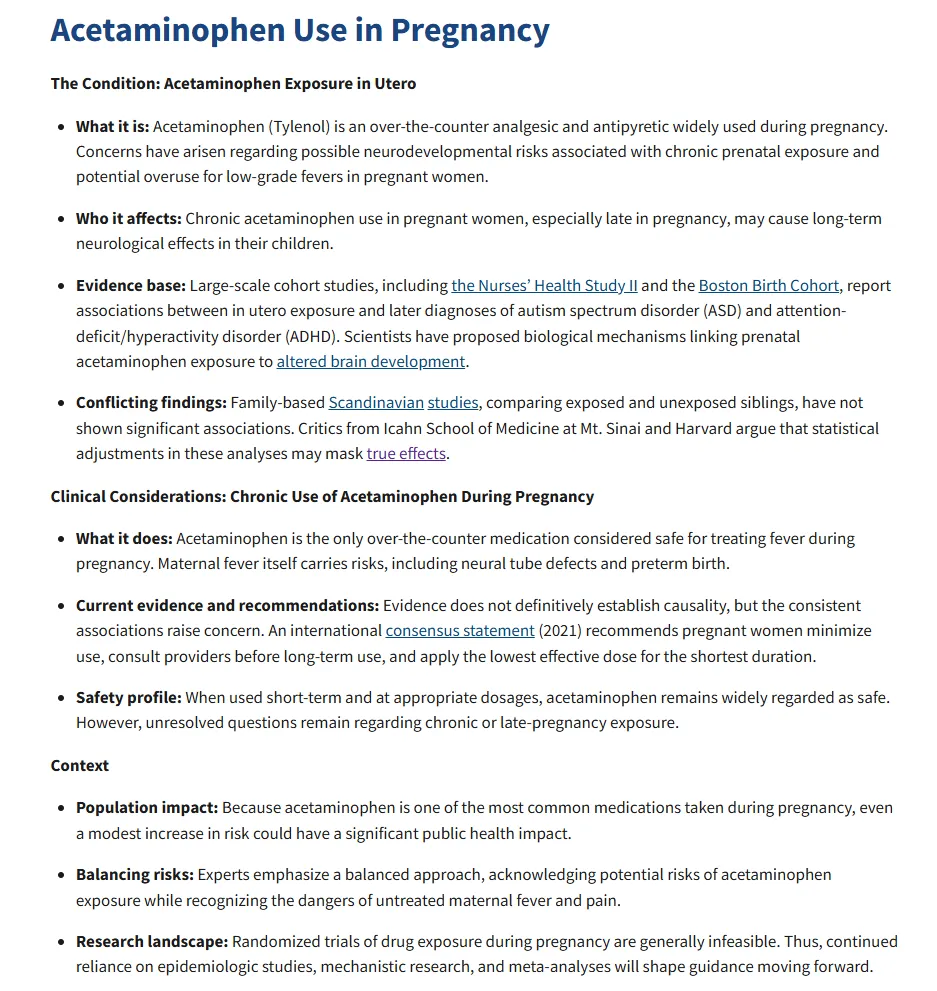
A section of the Autism Announcement Fact Sheet from the United States Department of Health and Human Services
When and why we use paracetamol (New Zealand perinatal context)
As many medical, Autism advocacy, and professional bodies have already stated, the aetiology of Autism is likely multifactorial, with genetic and environmental factors involved. However, Trump’s fearmongering about the association between Autism and paracetamol, a safe painkiller that can be taken in pregnancy and in labour, might get someone killed or leave them with a permanent injury. Pregnancy causes all sorts of aches and pains as the body adjusts to a growing fetus. However, sometimes pain experienced antenatally (before labour) can be abnormal, and can seriously impact mobility and/or quality of life. Options for analgesia that are safe for the mother/pregnant person and the baby are limited. Ibuprofen, a popular non-steroidal anti-inflammatory drug used as an analgesic (but also more effective against inflammation and fever than paracetamol) is not recommended after 20 weeks of gestation, because it can cause premature closure of the ductus arteriosus in the baby’s heart. This can cause high blood pressure in the fetal lungs, amongst other issues. Paracetamol can also be taken in labour. It is important to note that in these mostly non-emergency situations described above, paracetamol is part of a series of pharmaceutical and non-pharmaceutical interventions that are offered to the pregnant/labouring person. They can choose or reject whatever pain relief option they so choose, unless the clinical picture requires increasing intervention.
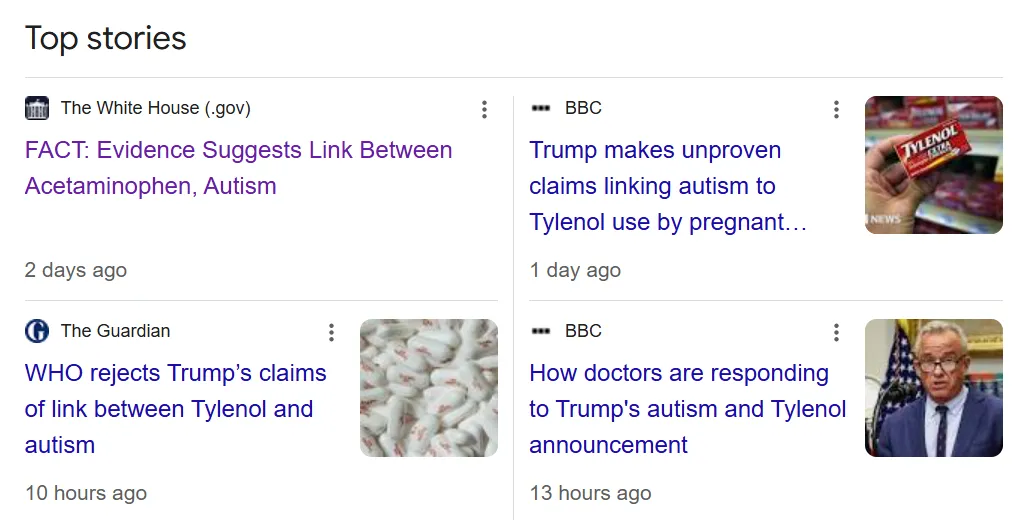
Top Google News stories from 25/9/25
A fever would be one such scenario where increasing intervention is needed. Fever can be caused by various bodily injuries and pathogens, serving as a sign that your immune system is working hard. However, if we don’t know what is causing the infection and aren’t addressing the cause correctly, this can result in preterm labour/birth, miscarriage, and possible birth defects. Sustained, elevated body temperature can cause damage to multiple organ systems, including brain damage if one’s temperature is 41-42 °C or higher. Children are also at risk of seizures if a fever fails to break.
New Zealand has a thorough maternal sepsis pathway, in which a temperature of less than 36 °C or over 38 °C is a major red flag. Fever is not the sole predictor of sepsis, and thus not the only vital sign that is measured. Still, it is a major one that is responded to quickly, with paracetamol and increased monitoring being the first response. IV fluids and IV antibiotics, alongside the collection of blood samples, soon follow. If someone has an extremely high fever (Trump isn’t clear on this threshold, but 41°C is considered a high-grade fever), your local neighbourhood midwives are not going to mess around with just 1 gram of paracetamol, but they aren’t going to omit it either.
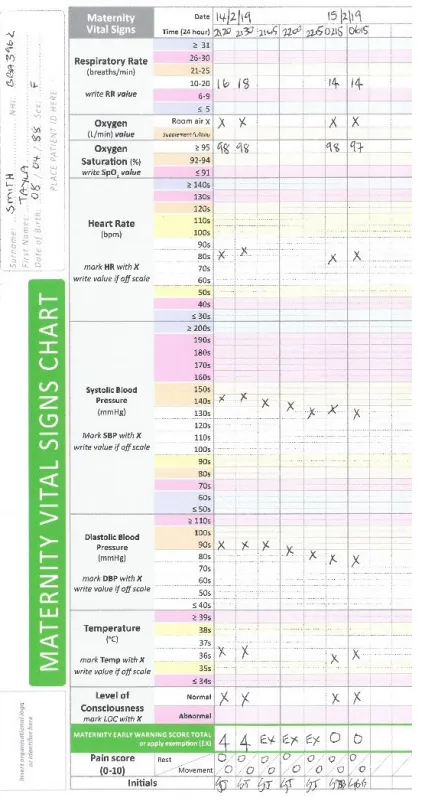
Example of Maternal Early Warning Score that is used to track vital signs of all pregnant/postpartum persons admitted to a hospital.
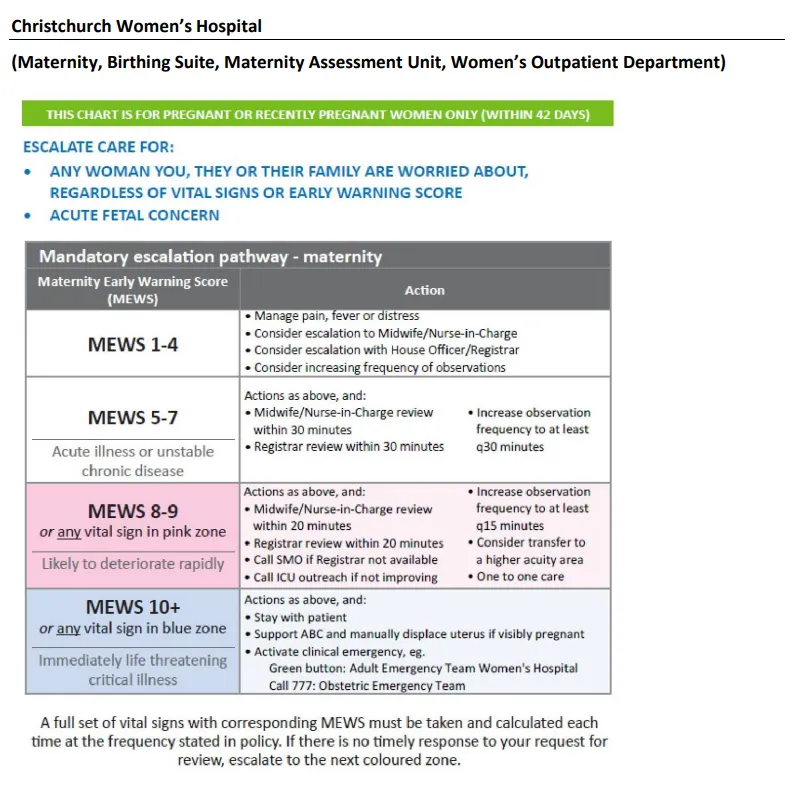
Example of an escalation pathway for Christchurch Women’s Hospital. Primary units will have a different set of actions for MEWS scores of 5-7, taking into account the need to transfer to a secondary/tertiary hospital.
To frame paracetamol usage as a matter of one not being able to “tough it out” is irresponsible, and ignores the major confounding factor of why someone took paracetamol during pregnancy in the first place. Fever is a particular case, given its diverse aetiology. I see at least two problems emerging: 1) There will be people who will wait until they have a high-grade fever before seeking help, leading to a significant increase in mortality and morbidity; 2) There might be a jump in antibiotic usage as a treatment measure, due to patient refusal to have paracetamol; this will have consequences not just for the individuals taking the antibiotics, but also in the global fight against antimicrobial resistance.
Let’s hope RFK Jr. doesn’t start on the research that found an association between Autism and antibiotic use in pregnancy.
What research is being used to justify the Trump administration’s claims?
As we wait for a full report to be released, let’s look at the studies quoted by the White House on a page titled FACT: Evidence Suggests Link Between Acetaminophen, Autism. The page includes links to what actually amounts to 2 pieces of original research, plus a systematic review and a consensus statement.
- Nurses’ Health Study II - A prospective study into women’s risk factors for chronic disease, consisting of 116,430 Female nurses between the ages of 25-42 in 1989. Subjects answered questionnaires and supplied blood and urine samples between 1996 and 1999, and DNA mouth swabs were also collected. This is valuable research. Ironically, this study is being conducted at Harvard University, which has been in a prolonged spat with the Trump White House over pro-palestinian protests on its campus. Funding was withdrawn and, in July 2025, over 50 years of specimens were at risk. As of September 17th 2025, it was announced that funding was reinstated, but the team has yet to receive any money.
The link provided leads to an article that is freely accessible. ADHD is the focus of this paper, and Autism is not mentioned once. Like many studies, the statistical analysis focuses on maternal factors (age, smoking status, medication use, chronic illness) and pregnancy outcomes (preeclampsia, gestational diabetes), while not asking the question of whether the mother had ADHD. From descriptions given in the article about the study, it doesn’t appear that nurses were asked about their own ADHD status.
-
Boston Birth Cohort - A cohort study initiated in 1998, with the goal of preventing preterm birth by examining social-environmental risks, as well as maternal and fetal genetics. In the 2019 paper quoted by the White House, cord plasma biomarkers from 996 mother-infant dyads indicated a significantly increased risk of ADHD and Autism which was sustained across multiple possible confounders such as substance use, smoking status, stress, maternal indication for taking medication, etc. Within the study limitations, it was noted that the measurement of cord biomarkers was one-time only and likely reflected use during labour, as paracetamol has a half-life in adults of just 3 hours. Further, the authors acknowledged that they were unable to exclude unmeasured genetic factors - again, maternal/paternal Autism and/or ADHD status was not reported as being collected.
-
Andrea Baccarelli is the Dean of Public Health at Harvard University. His review is a systematic review of 46 studies. It includes the sizable Ahlqvist study (which I will address below); if Ahlqvist is removed, then the majority of the included literature has a sample size of less than 120,000. While this is appropriately referred to as a review by the White House, its inclusion is somewhat cheeky. If your health or research literacy was low, you might walk away with the impression that this was a unique piece of research, rather than a synthesis of the literature. Both of the above articles are included in this systematic review, so presenting this as third on the list of supporting research is misleading. As loath as I am to help the White House, it would be far more honest to put Baccarelli’s review at the top and then place the Nurse Health Study II and the Boston Birth Cohort as sub-bullet points. Again, within the limitations and confounders of this topic, Maternal Autism/ADHD is not addressed specifically, although genetic factors are mentioned intermittently.
In the days since the press conference, Baccarelli’s review has come under fire. In a report by Rebecca Robbins and Azeen Ghorayshi of The New York Times, it was revealed that he had been paid up to $150,000 in 2023 for his services as an expert witness in a lawsuit against Kenvue, the maker of Tylenol. Baccarelli did declare this in the published article, and acknowledged it as a conflict of interest, but excluded information regarding the size of his payment. The case was dismissed for lack of reliable scientific evidence, with Baccarelli being criticised by the judge for misrepresenting the study results. Samuel Lovett of The Times quoted the judge Denise Cote’s comments:
“The discussion in his reports is incomplete, unbalanced and at times misleading. In general, Dr Baccarelli downplays those studies that undercut his causation thesis and emphasises those that align with his thesis.”
Baccarelli’s testimony, a source told Lovett, was repackaged into the 2025 paper that the White House and the HSS now present as supporting evidence. The academic debate is just now heating up with critiques of the review, and some pretty brutal takedowns of Baccarelli’s character are coming through thick and fast.
-
The sub-bullet point about Harvard University is just a link to Baccarelli’s review, as is the broken link for Mount Sinai. The dead link for Johns Hopkins University (which can be viewed via the Wayback Machine) is again the Boston Birth Cohort paper. We could joke that this mess of a website is what happens when you don’t invest in the humanities, but the truth is far more depressing than that.
-
The 2021 Consensus Statement is not wholly unreasonable, but neither are its critics (at least two note hereditary aspects of Autism/ADHD as an unexplored research issue). Those who signed the consensus statement include authors of the studies included in the Baccarelli review, and their concern about a wide range of risks paracetamol poses for neurodevelopmental, reproductive, and urogenital disorders. It acknowledges that paracetamol is an important drug, with limited alternatives, and recommends that women are advised to forgo it unless medically indicated, and to take the smallest possible dose for the shortest possible period of time. That advice in and of itself is reasonable, but anxiety about fetal risks, as one correspondent noted, does result in maternal deaths due to undertreatment:
_“However, a tendency exists to prioritise direct fetal risks and to overlook other risks to either party. Prescriber and patient anxiety about fetal risks has resulted in maternal deaths from pre-existing medical conditions due to undertreatment in pregnancy.
Doing nothing might at first appear to minimise the risk of harm. Inadequate treatment of pain and/or fever during pregnancy can be detrimental. Pain can itself have disruptive endocrine consequences, deleterious psychological effects might have a fetal effect, and immobility (which can result from untreated pain) can lead to venous thromboembolism. Pyrexia is associated with neonatal encephalopathy and fetal teratogenicity, which might be reduced by [paracetamol]”._
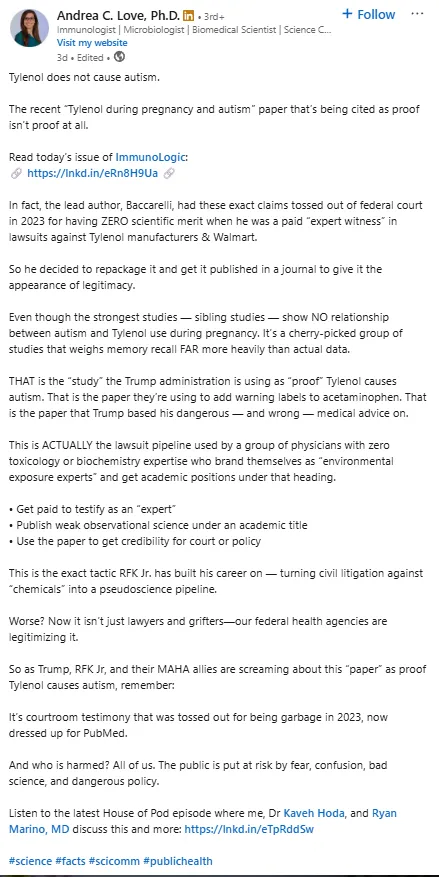
LinkedIn post by Andrea C. Love, Ph.D.
The authors of this response go further, pointing out that the timing and duration of use might also be an important factor, and that the concerns about long-term use might be overstated. They refer to a small study which surveyed 900 women in a maternity unit in Spain, which found that 99% took just the daily therapeutic dose (4g/day) and 45.7% did so for 3 or fewer days. However, 75% were told that paracetamol poses no risk to the fetus.
The main study that has been presented as a counterpoint to these studies is by Ahlqvist et al., published in 2024. It is a Swedish national cohort study of 2,480,797 children born between 1995 and 2019. 185,909 (4.7%) were exposed to paracetamol during pregnancy. When there was no sibling control, there was a marginally increased risk of Autism, ADHD, and intellectual disability; when sibling pairs were used to address any unobserved confounding, there was no remaining evidence of a connection. In their systematic review, Baccarelli makes a fair point that the rates of paracetamol exposure are low compared to other Swedish studies, which report usage rates between 56.4% and 63.2% - suggesting possible misclassification, and exemplifying a common problem within this topic: the accuracy of maternal self-reporting. On the other hand, the ‘other’ studies being cited have a completely different study design and far smaller sample size, which makes comparisons to Ahlqvist a bit difficult. Ahlqvist and team’s work goes further in identifying multiple confounders, such as the heritability of Autism/ADHD, and includes this within the demographic details of the parents.
Should we have been less surprised?
Yes and no. I think we all thought that vaccines would be blamed, because back in March RFK Jr appointed David Geier, an infamous anti-vax researcher, to lead a study on the links between Autism and vaccines. But, since early September, there were pretty clear hints/leaks that Kennedy and the Department of Health and Human Services were following the paracetamol rabbit hole. Conservative political activist Laura Loomer let the cat out of the bag on her X account back on September 3rd. Both the Wall Street Journal and The Atlantic published articles speculating on this matter on September 5th and 9th, respectively.
September was always going to be a tight deadline, but reports imply that concerns about paracetamol might have been a late addition. A Wall Street Journal article released after the official announcement claims the following:
“…officials were divided over how much emphasis to put on the painkiller and were planning to discuss it as one of many possible causes, people familiar with the matter said.
Doctors that Kennedy had selected to lead key agencies under him—Jay Bhattacharya, Mehmet Oz and Marty Makary—suggested the big story should be leucovorin, a little-known generic drug in which they saw promise for alleviating autism symptoms.
But a meeting with Tylenol’s maker convinced Kennedy to put the emphasis on acetaminophen.
Kennedy spent the first weekend of September poring over acetaminophen studies and calling scientists. After summoning Kirk Perry, interim CEO of Tylenol manufacturer Kenvue, Kennedy’s mind was set. He found Kenvue’s evidence in support of the drug to be poor, and became convinced that he had a moral duty to get the word out about the risk of acetaminophen as soon as possible, the people said.”
Tom Bartlett’s article in The Atlantic opened its report with a similar claim:
“For nearly a decade, the immunologist and biochemist William Parker has tried, with little success, to persuade other scientists to take seriously his theory that acetaminophen—better known by the brand name Tylenol—is the primary cause of autism. Researchers have long failed to find a causal link between autism and any medication, and these days, most of them believe that a change in diagnostic criteria is largely behind the dramatic uptick in autism rates over the past 30 years. But late last month, Parker received a phone call from Health Secretary Robert F. Kennedy Jr., who wanted to learn more about his work. In fact, he’s heard from Kennedy several times since then. Parker also spoke recently with Jay Bhattacharya, the director of the National Institutes of Health. To hear Parker tell it, the nation’s top health officials have taken great interest in his ideas.
Over the past few weeks, Kennedy has reportedly been looking into an alleged connection between autism and Tylenol use during pregnancy. Parker’s preoccupation is slightly different: He believes that children’s use of Tylenol causes autism.”
While the White House ultimately did focus on pregnancy, the inclusion of Parker’s research in the consultation process is troubling. The demonisation of childhood vaccines is already a public health challenge - how much worse will things get if Pamol (a brand of paracetamol formulated for children and babies) is targeted?
Social media fact or fiction?
While I have been enjoying the funnier memes about extra-strength Autism, it is also necessary to look at three of the more popular types of posts that are not only making the rounds on social media, but have also jumped into the real world.
Dr. Oz to profit from Leucovorin:

There are various versions of this claim, but it appears to have been debunked. Certainly, the speed at which the FDA is approving Leucovorin to treat Autism is, like many decisions made this week, quite troubling. Dr. Oz is no longer a spokesperson for iHerb, and has cut ties with the company, but whether iHerb will benefit regardless of his direct involvement is another story. FDA approval may be limited to Leucovorin and not to OTC versions or supplements, but iHerb did sell out of its version of folinic acid quite quickly.
Taking Paracetamol to own the Republicans:

Clips of pregnant women taking paracetamol are making the rounds on social media. Whether a deliberate piece of rage bait, an act of political defiance, or both, one thing is for certain - moral panic is making everyone’s engagement numbers skyrocket this week. So far, no one has died from this stunt, but several of my brain cells did.
Did Tylenol actually make that tweet?
Yes, in 2017 Tylenol did tweet the following and has been doing damage control over the past several days:
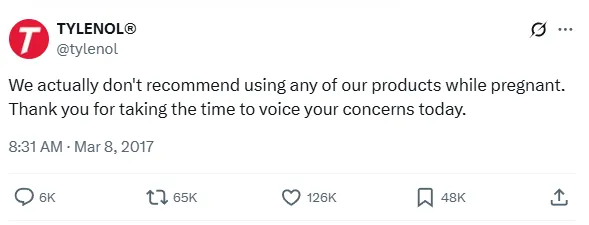
Tylenol’s parent company states that the tweet has been taken out of context, doesn’t reflect their full guidance, and was in response to a customer tweet that has long since been deleted. What a company thinks about how and when its products should be used is sometimes more of a deflection of legal responsibility than a reflection of their actual safety and utility. For decades, the pharmaceutical company Searle refused to have Misoprostol approved for use in pregnancy, despite evidence that it was safe and effective to use for both induction of labour and in the treatment of postpartum haemorrhage. Why? Because it can also be used as part of the abortion process, which, due to the Mexico City policy/Global Gag rule, can make global distribution a nightmare.
I, like many nosy people, tried to figure out what that original tweet was. The handle changed hands in 2020, but there is a cached version from 2015. The original owner of the Jen_in_TX handle was named Jennifer McAnally, and they were definitely anti-acetaminophen before it was cool:

Maybe the original @Jen_in_TX will stand up and claim their own slice of viral infamy, but I doubt we would be surprised about what their original question was.
So what can I do as a Skeptic?
In times like these, it is more important than ever to be critical consumers of media, and alert to the financial/vested interests that may underpin research. You can stay informed about advancements in health and updates in health practice by following key professional bodies in New Zealand (i.e. RANZCOG, NZCOM), and seeking out commentaries or responses in peer-reviewed journals. Science-Based Medicine and Retraction Watch remain high-quality, reliable resources for Skeptics to turn to.